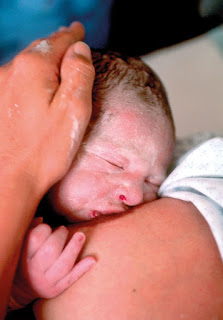Babies are smart!
The first ‘magic hour’ after birth
I only need to
look at my grandchildren to marvel how true this is. I studied paediatrics to learn
about developmental milestones, yet, they (like babies all over the world) know, exactly what to do, when and how - without opening a book!
Newborns are programmed to survive. They’re
little ‘toughies’ and yes, there may be times when they need a bit of help, but
generally speaking, just about all babies manage to get through the first
critical hour after birth on their own.
More and more, doctors
and midwives are learning the value of not interfering, and giving
newborn’s the chance to recover from birth and adapt to living in the air on
their own. Just like baby turtles paddling their way down the beach towards
the sea, a newborn’s first mission is to ‘crawl’ over the contours of mom’s
body to find their way to her nipple where they’re rewarded with their first suckle
at the breast.
Why is this so
important and how can it be achieved?
It’s not that babies
have to eat as soon as they are born. On the contrary. They simply suckle at
the breast to connect with mom, absorb microbiomes (good bacteria) from her
skin and find comfort hearing her heartbeat.
In the first
hour after birth, the baby is adapting from living like a little fish in the water
to living on land and breathing oxygen. It took land-creatures millions of
years to learn how to do this – newborn’s do it in the first few minutes after
birth!
Breathing is
their first step to independence. After this comes suckling – not only for
nourishment, but also to self-soothe. Remember that when we were primitive
babies, we were at risk from predators, and incessant crying could attract
unwanted attention. * Babies need to find comfort from their mothers to
overcome the shock of birth, to be reassured by her beating heart, and
nourished by precious colostrum – baby’s first food.
During the first
hour after birth, mom and baby are at their peak of ‘alertness’. The baby, once
patted dry, is covered with a cloth, and left naked, skin-to-skin on mom’s
flattened tummy where s/he is free to ‘crawl’ toward the target – her nipple – that's been darkened
by pregnancy.
Babies are instinctively
drawn to mom’s left breast where her heartbeat is strongest. This very first ‘tummy-time’,
reconnects mom and baby like a magnet. Mom’s sense of relief and elation now
that her ordeal is over, pumps up hormones like endorphins (happiness) dopamine
(motivation), and oxytocin (the love hormone) that, in turn, help her to adjust over
the next few critical days to her new role as mom. A glut of these hormones also
helps to minimise ‘baby blues.’
We would be blown
away if we could zoom onto the surface of mom’s skin to see what’s happening. Thanks
to research, the microbiome (good bacteria) and its benefits are in the
spotlight. These ‘healthy’ micro bacteria are passed from mom to baby during
the birth, skin-to-skin contact, and breastfeeding. When the baby swallows these
microbiomes, they’re colonised in the baby’s gut, helping the baby to digest
milk and initiating immunity. It's nothing short of a miracle.
We’ve learned
that babies don’t need to be taught how to breastfeed. All they need is time
and patience and ‘hands-off’ from doctors and midwives. Left alone, the baby’s
senses (sight, sound, smell, touch and taste) along with the sucking and rooting
reflexes help to jumpstart breastfeeding.
* More about this in my next blog.









